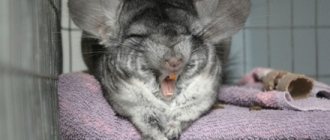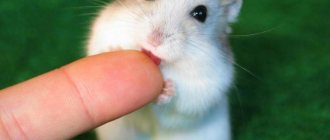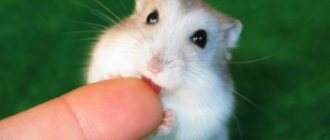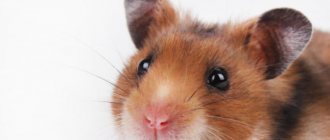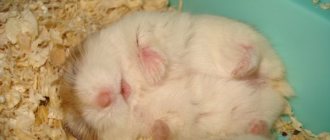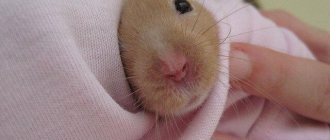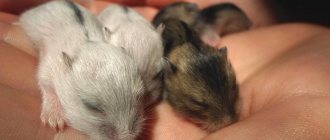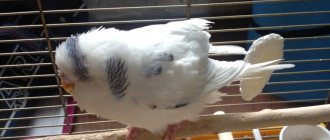A healthy hamster does not make many sounds - it scratches in the bedding and squeaks its wheel. If the pet suddenly starts snorting and squeaking, the owner wonders what to do if the hamster sneezes. Frequent sneezing is by no means the norm for these animals, and such a problem requires treatment .
When an animal sneezes and coughs, this is an attempt by the body to clear the airways. Along with a sharp exhalation, mucus, small particles, and microorganisms fly out. Sneezing and coughing are involuntary reactions based on reflexes. Therefore, a pet cannot “simulate”; it is necessary to look for the cause of the symptoms.
Why does a hamster squeak?
Understanding the reason for a pet's restless behavior is always difficult, because its squeaking can be associated with a variety of factors. It could be:
- stress;
- lack of drinking water;
- bad dreams;
- disease.
If you recently acquired an animal and the environment is still unusual for it, its squeaking is associated with stress and moving. In this case, the animal becomes afraid of unfamiliar smells and places. It can take 3 weeks or 3 months for the animal to adapt, it all depends on the individual characteristics.
The next reason for a hamster's nervous behavior is lack of water. The pet is trying to attract the attention of its owners and provide itself with vital moisture. In nature, individuals of the hamster family receive water, as a rule, in the morning, when dew appears on the plants.
It is also not uncommon for pets to be noisy in their sleep. This is because hamsters dream, and apparently they aren't always good ones. In this case, the animal emits short intermittent squeaks.
The most serious reason for your pet's squeaking may be illness. The owner needs to take a close look at the behavior of his pet and observe him for some time. If you find that there are any other changes in the behavior of the animal, for example, sneezing has appeared, it is worth familiarizing yourself with the reasons for sneezing in hamsters.
What to do: general recommendations for treating a runny nose
Sneezing in a pet is a serious reason to think about more careful care and maintenance. To prevent and exclude colds, you should carefully monitor the appearance, condition and behavior of your pet. Clean, shiny coat, clear eyes and activity confirm the pet’s healthy state of health. The slightest changes in the pet indicate an upcoming illness.
If sneezing is short-term, then it is worth taking preventive measures to eliminate possible causes and monitoring your pet. In a healthy hamster, the sneezing should subside within a couple of days. If you sneeze frequently with snot, you should immediately visit a doctor with a first aid kit for your pet.
The simplest recommendations will help maintain the health of your rodent:
- Maintaining the temperature in the room.
- Drink plenty of fluids freely available.
- Constant feeding with vitamin complexes.
- Compliance with dietary rules.
- Timely cleaning of the cage.
- If there is discharge from the eyes or nose, an immediate visit to the veterinarian is recommended.
Hamsters are susceptible to colds. Due to the fragility of the body, the disease develops very quickly, and only competent actions by the owner will help the small pet quickly and painlessly recover from illness.
Respiratory diseases
The most serious cause of sneezing is a cold or respiratory infection. A cold can start when the animal is exposed to constant drafts. To prevent this, it is necessary to place the cage in a place protected from drafts; several panels or screens can be placed on the sides of the cage. You should not put the animal in an aquarium, since the ventilation in it will be very poor, which will greatly affect the health of the pet.
It is quite easy to distinguish a cold:
- The pet's nose becomes wet.
- The activity of the animal is significantly reduced.
- My eyes are watering.
If you notice such changes in the appearance and behavior of the animal, you should immediately transplant it to a warmer place - the temperature should be from 24 to 27 degrees. It is recommended to give chamomile to your cold pet. Gamavit 0.1 ml should be dripped into the mouth, 1-2 times a day. If the animal does not get better after a few days, it should be immediately shown to a veterinarian.
If a cold is left untreated for a long time or the animal is allowed to become severely hypothermic, pneumonia may develop. With pneumonia, lacrimation begins, breathing becomes difficult, and wheezing is heard. The pet becomes drowsy and lethargic. In such a situation, independent treatment is impossible; you must immediately show your pet to a veterinarian and purchase all the medications prescribed by him.
Under no circumstances should you treat an animal in the same way as the human body. You cannot treat it with antibiotics and folk remedies, since many medications are destructive to the animal’s body and will greatly harm it.
Pneumonia
An advanced cold leads to pneumonia. Moreover, this can happen literally within a day. The disease is complex and is diagnosed by a veterinarian using x-rays. Signs associated with the disease:
- Attacks of suffocation;
- Disorientation in space;
- Difficulty breathing with wheezing.
- Weight loss;
- The eyes fester.
The hamster sneezes and squeaks due to weakness in the body. For pneumonia, antibiotics, diuretics, and warming are prescribed. If drug treatment is not carried out, the hamster will die.
Prevention of colds
If you don’t want to learn in practice what to do if your hamster sneezes, you should prevent colds. For this, you can use some homeopathic medicines, but only as prescribed by a specialist.
Chamomile decoction can also be used to prevent colds. To do this, pour boiling water over the chamomile, let it brew and cool. After this, strain and soak a piece of white bread with the resulting broth. The advantage of this method is that the animal will immediately place the roll with chamomile infusion into the cheek pouches and disinfect them, as well as the oral cavity.
If you follow all the recommendations regarding bedding, food and temperature conditions, as well as periodically carry out preventive maintenance, you will not have to wonder why my hamster squeaks and sneezes?, and your pet will feel great.
Bedding material
Often the cause of allergies is wood shavings or sawdust. The main factor that can provoke sneezing in an animal is small dust particles, as well as aromatic oils contained in wood. There is an opinion that sand should be used as bedding. However, such a statement is far from the truth. Veterinarians do not recommend using any fine-grained structures as bedding. Sand dust often penetrates the respiratory tract of animals, causing not only sneezing, but also serious respiratory diseases. For hamsters, it is worth buying special mixtures that will not harm the animal. Such compositions do not cause allergies and do not penetrate the respiratory tract of pets.
The hamster sneezes. Be healthy, baby!
Domestic hamsters do not naturally have strong immunity. Due to the accelerated metabolism, any disease in these animals progresses very quickly. Therefore, you should be careful about your pet's health. to start treatment on time and prevent complications.
There can be many reasons for a hamster sneezing.
Sneezing is a protective reaction of the body aimed at removing mucus, dust and other irritating factors from the upper respiratory tract through a sharp exhalation.
The reasons for this reaction in hamsters can be:
- Hypothermia
- Infectious diseases
- Reaction to any allergens
Often sneezing is accompanied by the squeaking of a domestic rodent and is a symptom of the following diseases:
- SARS
- cold
- rhinitis
- bronchitis
- pneumonia
- allergy.
Allergic reactions in hamsters most often occur to food and household chemicals.
Causes of sneezing in rodents
The most common reason why a hamster sneezes is that small particles of sawdust from bedding or bathing sand get into the nose. The breeder must carefully consider the choice of filler; the sawdust should not be too small and fragrant. For this reason, pine shavings are not suitable for rodents - they contain resins that cause allergies. Printed paper or newspaper is also a bad option, as the dyes contain many harmful components and can often cause sneezing. Sneezing can be caused by other reasons:
Allergies can occur to food products. Do not forget that almost all “human food” is contraindicated for hamsters: meat and sausage products, salted, smoked foods, any sweets and baked goods, fruit juices and tropical fruits, some nuts (almonds). Do not “treat” your hamster with junk food so that you do not have to treat the consequences.
Allergies are caused by any chemicals. Do not use detergents to disinfect the cage; wet cleaning with plain water is sufficient. If necessary, you can use laundry soap, rinsing it well with water. Do not spray air fresheners, hair styling products or deodorants near the cage. Small particles entering the pet's respiratory tract cause severe irritation and frequent sneezing.
A new toy in the cage can also be a source of sneezes if it is made of toxic plastic or rubber. If your hamster sneezes after interacting with a person, the reaction could be caused by the scent of perfume, cosmetics, or another strong odor.
If your hamster starts sneezing after walking around the apartment, the cause may be ordinary household dust.
Rhinitis
Inflammation of the nasal mucosa due to hypothermia leads to a runny nose in a hamster. And also rhinitis can be allergic. In such cases, its appearance is provoked by dust contained in the bedding or filler.
Signs of rhinitis include:
- Discharge from the nasal passages.
- Sneezing.
- Difficulty breathing.
Since the symptoms of a runny nose closely resemble those of pneumonia, only a veterinarian should make a diagnosis. Natural preparations are used for treatment; in some cases, inhalations will be needed. It is imperative to get rid of the cause of the disease.
Respiratory irritants
Sometimes, due to the smell that the hamster emits, the hamster may sneeze because of something that is around it. Respiratory irritants may include perfumes, pine and cedar shavings, scented candles, electric diffusers, and scented room sprays. Even some cleaning products can irritate your hamster's tiny, sensitive airways. If you are using one or more of these possible respiratory irritants, you should easily stop using them around your hamster or move the hamster's cage away from the source of the smoke. If you use pine or wood shavings, consider switching to recycled paper towels or bedding.
Control measures
The fight against sneezing consists of treatment (in the case of bronchopneumonia, as well as rhinitis) and elimination of irritants. Of the treatment methods described by hamster breeders, acceptable ones include cleaning the eyes and muzzle from secretions, as well as placing antimicrobial ophthalmic drops, for example, Tsipromed, on the nose twice a day.
The idea of fortifying drinks is pointless; the active ingredients decompose within two hours. It is much more effective to constantly keep dry fortified treats purchased at the pet store in the cage.
It is doubtful whether you need to heat your hamster; you can overdo it and he will get heatstroke, which is more dangerous than sneezing. But it is necessary to protect the animal from drafts. You can put a piece of paper towel in the cage, it will be more fun for the hamster.
If sneezing is caused by allergic phenomena, the following measures should be taken:
- Stop smoking and using cosmetics.
- Remove ornamental plants.
- Replace toilet filler with hypoallergenic one.
- Instead of economy-class feed, use premium quality food.
To prevent a hamster from sneezing, it is necessary to create a comfortable environment for it, protect it from drafts, not treat it with human food, stop treating it like a toy, not bathe it, and not invent other methods of torment. The animal is sensitive to lack of attention, but tolerates excess much worse.
We invite you to join our group on VKontakte or Odnoklassniki, where new articles for pet owners are published.
Cold
Unfortunately, colds are a common disease in rodents. The slightest breath of wind, illness of the owner or poorly dried hair after bathing can cause the pet to catch a cold. The hamster not only sneezes and snorts, the rodent’s appetite also decreases, it sleeps for a long time and breathes heavily. A cold is accompanied by snot discharge, and the animal often rubs its nose.
- Three times a day Sulfazin at the rate of 0.1 grams per 1 gram of rodent weight.
- Oxytetracycline injections subcutaneously, 10 mg per 1 gram of weight.
- Using a pipette, rinse your nose with a weak solution of Streptocide twice a day.
Colds can be prevented by following the conditions of detention and taking 20 mg of ascorbic acid for a month.
In case of complications of the disease, a mandatory visit to the doctor is required.
If you have several pets in the house, you need to isolate the sick animal.
What is the lifespan of a hamster?
